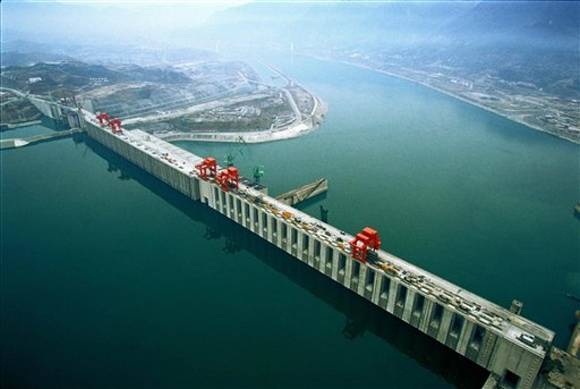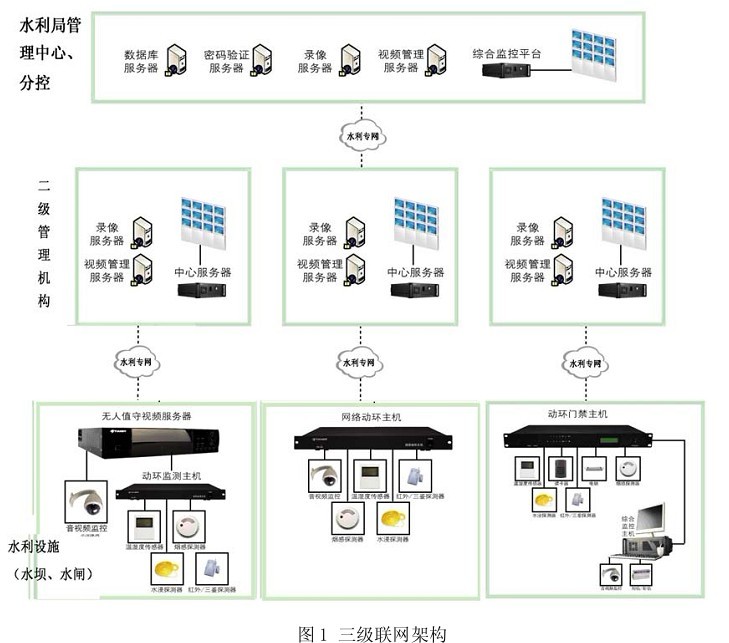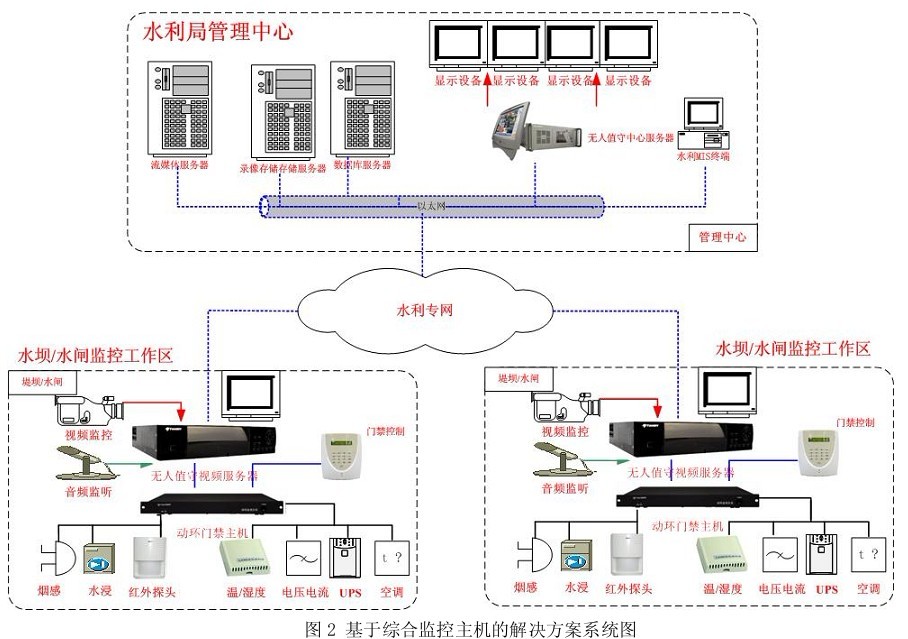

1、 Development trend of unattended system in water conservancy safety monitoring
Lakes, rivers and watercourses are rich in water resources. Transforming hydraulic power into water conservancy has been a project beneficial to the country and the people in China since ancient times. Such as the Three Gorges project, the South-to-North Water Transfer Project and so on, all reflect the benign use of water resources. However, the safe operation and maintenance after the construction of water conservancy facilities is the top priority. If the management is not good in the later stage, it may directly lead to the reduction or even loss of the function of water conservancy facilities, but impose a burden on the safety management of water conservancy. With the continuous development and construction of water conservancy projects, the state has put forward new requirements for various water conservancy facilities themselves, as well as the automatic operation of water conservancy facilities and the safety of equipment and facilities. In addition, the rapid development of modern communication technology and video technology provides a strong technical guarantee for the digitization of water conservancy construction. Therefore, reforming and optimizing the safety monitoring of water conservancy facilities, building the computer room of water conservancy industry through the remote video monitoring system and control of various communication technologies, and realizing "unattended (few people on duty)" is the overall trend of the development of water conservancy and hydropower industry.

2、 Current problems in water conservancy facilities monitoring
At present, water conservancy facilities mainly include arch dam, gravity dam, RCC dam, core rockfill dam, face rockfill dam, etc. Due to the relatively large volume of the dam, the cross section is relatively wide. The sluice is mainly River, which is much smaller than the overall volume of the dam. It is basically a dam at one time, such as the ear sluice on the Xinkai River in Hebei District of Tianjin. The water conservancy monitoring system requires timely and accurate information collection, simple information processing operation and convenient maintenance, as well as convenient system installation, stable operation and long maintenance cycle. At present, there are mainly the following problems:
1. For large-scale water conservancy facilities such as dams, the main control rooms are located at both ends of the dam, which are far away and inconvenient to communicate with each other. Problems can not be found and handled in time. Even if fixed personnel are arranged, it is difficult to centralized monitoring and management. In addition, in some areas, the water conservancy monitoring points are scattered and the natural environment is poor. In this case, arranging special personnel for management not only lags behind, but also is very dangerous.
2. The traditional video monitoring not only occupies a large bandwidth, but also cannot realize the equipment safety management and alarm processing in the dam body and the general control room. It has a single function, which is difficult to meet the requirements of the dam body with high safety alert, and is not convenient for the monitoring and supervision of the superior leaders. Moreover, the traditional monitoring scheme separates video monitoring and dam safety monitoring to form two independent subsystems, which not only increases the complexity of operation, but also increases the cost of software and hardware maintenance.
3. If the monitoring system is adopted in multiple monitoring rooms, the maintenance cost is too high, and the video monitoring, perimeter alarm and power environment equipment around the dam cannot be monitored and managed uniformly and centrally.
4. In case of alarm in water conservancy facilities, it is impossible to obtain detailed video and equipment monitoring information at the first time only by relying on the nearby personnel on duty to solve the problem on site or notifying professional technicians by telephone, which reduces the response speed of the system. If the problem is serious, the consequences will be unimaginable.
5. If the traditional security work is followed, it will not only waste a lot of human resources, but also take a long time to deal with the problems after they appear, and the problems can not be tracked and traced back, so it is difficult to quickly find the root cause of the problems, which is not conducive to information management.
3、 How to solve the problems existing in water conservancy monitoring
In view of the current situation of monitoring in the water conservancy industry and combined with the actual situation of customers, the "unattended integrated monitoring system for dam / sluice water conservancy" is launched to meet the above problems.

1. The security monitoring system not only provides real-time video browsing in the front-end operation area, but also realizes various operations such as linkage light on, alarm bell, sending SMS or MMS, controlling the switchgear in the dam and sluice when the access control and power environment equipment alarm. The alarm information is uploaded to the network management center and the network management sub control center at the same time, and the center can also conduct remote guidance or operation to eliminate dangerous situations, so as to deal with accidents in time.
2. The overall design of the software platform is designed according to the two-tier or three-tier network structure, and the local monitoring system is set in the front-end operation area, including dam sluice equipment monitoring, dam sluice surrounding area monitoring, perimeter alarm system, fire alarm system, access control system, lighting voice control system, dam sluice working area power environment monitoring. The monitoring center uniformly supervises the front-end monitoring points through the monitoring center end software, including alarm processing, data report analysis and remote management.
3. The front-end monitoring system can increase various required monitoring equipment by expanding RS232 standard industrial interface and adopting relevant equipment communication protocol. For example, instruments for hydrological monitoring, seepage pressure gauge, inclinometer, joint meter, etc. for dam safety. In this way, users do not need to add computer equipment, and the use of a set of monitoring software also greatly reduces the complexity of operation.
4. Through the video monitoring of the front-end operation area, we can observe various changes in the water area, the operation of equipment in the machine room and culvert gates in real time, provide intuitive image information for leaders' decision-making, improve the working environment of observation and measurement staff, reduce staff, achieve unattended and few people on duty, and truly reflect modern management and intelligent operation. For example:
1) A variety of alarm and treatment measures are used for water level monitoring, which can monitor the water level of the reservoir through video to ensure the safety of water level;
2) The sluice, water pump station and reservoir spillway shall be monitored by real-time video to avoid misoperation and unattended;
3) Use video monitoring to analyze the hydrological conditions of the river, monitor the upstream, downstream and both banks of the river, and monitor the water quality of the river to prevent pollution;
5. The use of proxy forwarding server software can greatly reduce the bandwidth. In addition, after installing ie sub control software on the front-end monitoring host, leaders at all levels can use IE browser to check the operation of water conservancy facilities in all parts of the world through the network.
6. Through the multicast voice intercom technology, multiple front ends can communicate with the center. Through the voice intercom function, the center technicians can provide technical guidance to the front-end personnel through video and intercom, which greatly improves the maintenance efficiency and reduces the maintenance cost.
4、 Advantages of water conservancy unattended integrated monitoring system
The characteristics of remote monitoring of water conservancy departments, such as the remote monitoring of water conservancy departments, can not meet the needs of the traditional monitoring of water conservancy departments. How to effectively enable users to obtain smooth and clear surveillance video under the existing bandwidth is the key to the success or failure of the system design. "Water conservancy unattended integrated monitoring system" has been constantly summarized in many years of practical application. Through a reasonable structure, it has effectively solved a variety of problems in the water conservancy industry and met the actual needs of water conservancy users.
The remote communication of "water conservancy unattended integrated monitoring system" adopts standard TCP / IP protocol, which can be directly applied to LAN or WAN. In view of the long distance of each gate station and the difficulty of laying wired lines, wireless spread spectrum technology or satellite communication can also be used to solve the problem of long-distance communication. At the same time, the software adopts the popular three-level network architecture, which makes the whole system structure clear and easy to manage and expand. At the same time, the system supports the agent function. In addition, the system also supports network sub control and IE sub control, so that the whole system can be connected freely without geographical restrictions.
The whole system is divided into four parts: the front end is unattended video server and video, power environment and access control; Proxy forwarding server (optional);
The center is a server system of network sub control and unattended center; Ie sub control. The solution system based on unattended video server is shown in Figure 2:
The system can carry out 24-hour video monitoring on the key parts of all front-end dams / sluices, and can set video recording on different front-end in different ways.

The system can be connected with a large number of alarm equipment, such as door magnetism, infrared, smoke, water immersion, etc. in case of abnormality, the system can automatically alarm, upload alarm information, and linkage digital video recording or acoustic photoelectric alarm.
The access control interface can be added to the system, and the access control system can be seamlessly connected to strengthen the management of personnel in and out of the dam / sluice. Through audio and video monitoring, managers can see the working conditions of equipment and field staff anytime and anywhere, and can also talk with front-end staff to strengthen the interaction of management. The system can also be combined with a large number of professional environmental monitoring equipment to timely reflect the data of air conditioning system, temperature and humidity and other guarantee equipment.
Complete video recording strategy can be linked in case of alarm, and MMS or SMS can be sent to inform the personnel on duty or relevant leaders and technicians.
In addition, if we want to truly realize intelligent unattended monitoring, we also need to increase the dam's own safety factors and hydrological monitoring in the system. Truly achieve all-round, integrated and intelligent monitoring.
Solutions for water level monitoring:
At present, the monitoring of hydrology mostly uses the professional water level gauge alone. The computer communicates with the equipment through RS232 to collect data in real time, and the software processes the alarm parameters set by the user. This method has disadvantages. If the equipment is damaged or strongly interfered by the outside world, it is likely to cause data distortion and false alarm information. Moreover, the center only gets digital information, lacking sensory information.
The unattended system adopts the method of combining video technology and measuring equipment. In addition to using water level measuring equipment, it also adopts the relatively advanced video analysis technology, sets an independent water level monitoring video channel, and sets a water level warning line in the video window. If the water level crosses the warning line, an alarm signal will be generated. In this way, the alarm information is more intuitive and accurate, At the same time, the monitoring center can find the alarm in advance through video analysis. In this way, we can not only deal with the alarm in time, but also achieve the function of early warning. At the same time, cooperate with SMS or MMS to timely convey the alarm information to the relevant responsible person.
For the horizontal displacement of the dam, while using the fixed-point displacement meter to measure, we use the video Superposition Technology to superimpose the coordinate axis into the video image, and align the measuring point of the displacement meter with the center of the video coordinate. The central monitoring end can analyze the displacement through video, but the displacement of the dam body is very slow, so we need to combine the dual measurement of the measuring instrument.
While monitoring the dam safety, we cannot ignore the video monitoring of the gallery, because the gallery is a diversion channel after the water seepage enters the dam body. If there is too much ponding in the gallery, the seepage problem of the dam body is very serious and poses a major threat to the safety of the dam body. The key technology of the dam / sluice water conservancy unattended integrated monitoring system realizes the full-automatic control and management of "unattended and few people to take care of" for the sluice of medium and large dams, which provides conditions for the reduction of staff and efficiency of the sluice of the dam. When the system realizes network monitoring, data sharing can be realized, which provides great convenience for management. With the approach of flood season, the high integration, high stability and intelligent unattended integrated monitoring system will play a vital role in practical work.

 销售王经理
销售王经理
 微信公众号
微信公众号